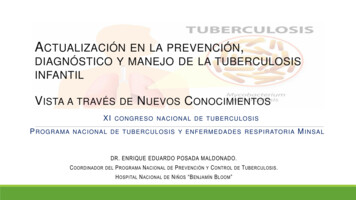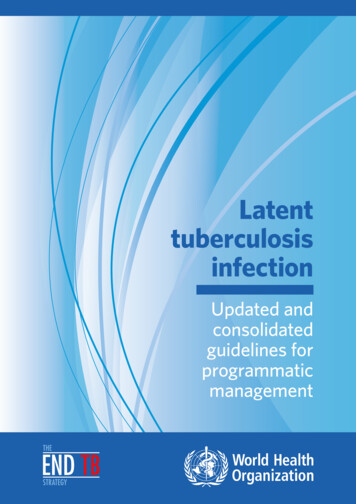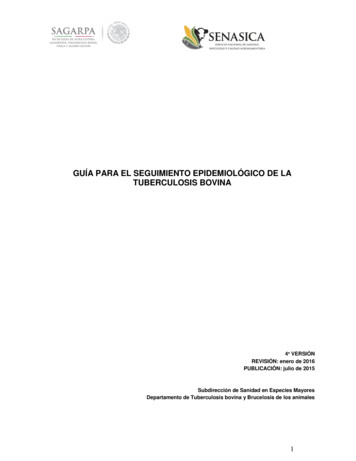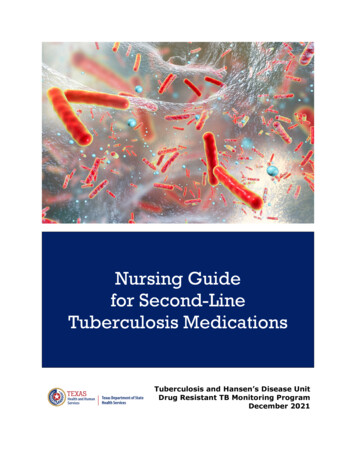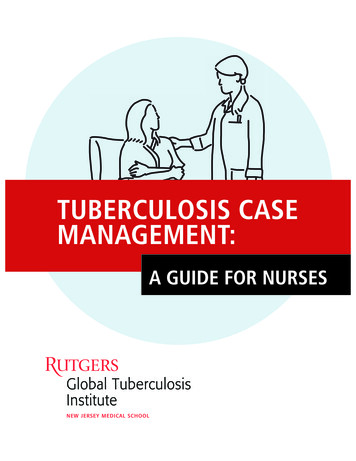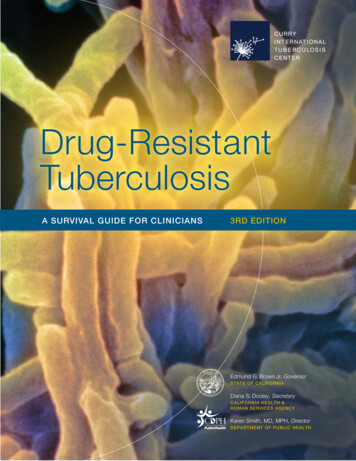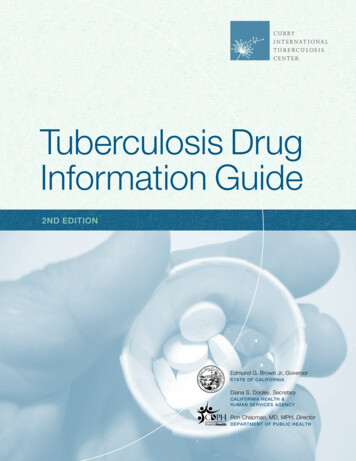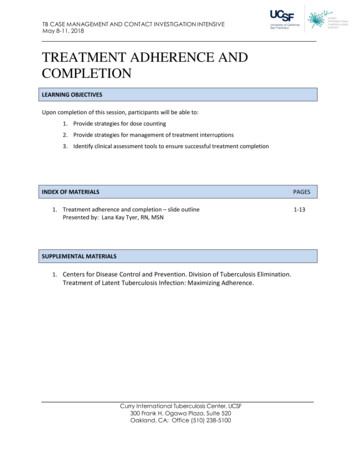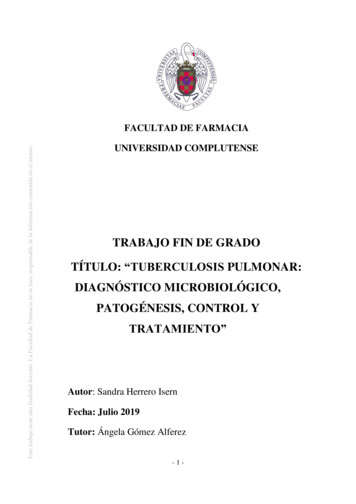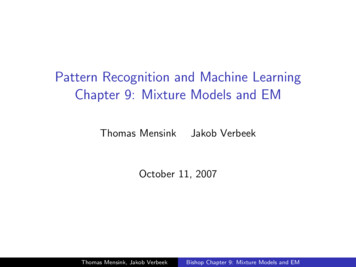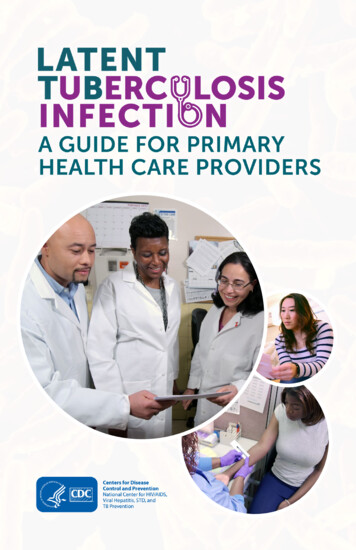
Transcription
LATENTTUBERCULOSISINFECTION: A GUIDEFOR PRIMARY HEALTHCARE PROVIDERS
U.S. Department of Health and Human ServicesCenters for Disease Control and PreventionNational Center for HIV/AIDS, Viral Hepatitis,STD, and TB PreventionDivision of Tuberculosis EliminationAtlanta, Georgia20202
TABLE OFCONTENTS4List of Abbreviations5Introduction6Targeted Testing for Tuberculosis8Diagnosis of Latent TB Infection (LTBI)20Treatment of Latent TB Infection (LTBI)36Appendix A37Appendix B38Appendix C404244Sample TB Risk Assessment ToolIdentifying Persons from High Burden CountriesAdministration and Measurement of the TSTAppendix DSituations Where Results from Both a TB BloodTest and TST May be UsefulAppendix ESample Documentation FormsAppendix FLatent TB Infection Treatment Regimens46Appendix G5457ResourcesLTBI Testing and Treatment: Summary ofU.S. RecommendationsReferences3
AFBacid-fast bacilliAIDSacquired immunodeficiencysyndromeALTalanine aminotransferaseARTantiretroviral therapyASTaspartate aminotransferaseATSAmerican Thoracic SocietyBCGbacille Calmette-GuérinCDCCenters for Disease Controland PreventionLIST OFABBREVIATIONSDOTdirectly observed therapy4FDAFood and Drug AdministrationHIVhuman erferon-gamma releaseassayINHisoniazidLTBIlatent tuberculosis infectionMDR TBmultidrug-resistanttuberculosisMMWRMorbidity and MortalityWeekly ReportNTCANational TuberculosisControllers AssociationPPDpurified protein derivativeQFT-PlusQuantiFERON -TB Gold PlusRIFrifampinRPTrifapentineSATself-administered therapyTBtuberculosisTNF-alphatumor necrosisfactor-alphaT-SpotT-SPOT .TB testTSTtuberculin skin testUSPSTFU.S. Preventive Services TaskForceWHOWorld Health Organization
INTRODUCTIONTuberculosis (TB) is caused by a bacterium called Mycobacterium tuberculosis(M. tuberculosis). Not everyone infected with TB bacteria becomes sick. Asa result, two TB-related conditions exist: latent TB infection (LTBI) and TBdisease. It is estimated that up to 13 million people in the United States (U.S.)have LTBI. People with LTBI are infected with M. tuberculosis, but they do nothave TB disease. People with LTBI do not have signs and symptoms of TBdisease, and they cannot spread M. tuberculosis to others. While not everyonewith LTBI will develop TB disease, about 5–10% of infected people will developTB disease over their lifetimes if not treated for LTBI.Progression from untreated LTBI to TB disease accounts for approximately80% of U.S. TB cases. Identifying and treating people with LTBI is essential forcontrolling and eliminating TB disease in the U.S. LTBI treatment is effective forpreventing TB disease. Primary care providers play a key role in achieving thegoal of TB elimination because of their access to populations at high risk for TB.This guide is intended for primary care providers who care for individualsand populations who may be at risk for infection with M. tuberculosis. Thisdocument is not meant to be used as a substitute for CDC guidelines, butrather as a ready and useful reference. For detailed information regarding thediagnosis and treatment of LTBI, please refer to the following CDC guidelines: Guidelines for the Treatment of Latent Tuberculosis Infection:Recommendations from the National Tuberculosis ControllersAssociation and CDC, 2020 American Thoracic Society/Infectious Diseases Society of America/Centers for Disease Control and Prevention Clinical Practice Guidelines:Diagnosis of Tuberculosis in Adults and ChildrenFurther guidance can be found in the References section, Appendix F, andAppendix G. Clinicians should contact their state and local TB control offices foradditional information on diagnosing and treating LTBI. Contact information canbe located on the State TB Control Offices website.5
TARGETED TESTINGFOR TUBERCULOSISTargeted testing is an essential TB prevention and control strategy that is usedto identify and treat individuals with LTBI who are at high risk for developingTB disease. Identifying individuals with LTBI is essential to the goal of TBelimination because treatment of LTBI can prevent infected individuals fromdeveloping TB disease and thereby stop the further spread of TB to others.The CDC and the U.S. Preventive Services Task Force (USPSTF) recommendtesting people who are at increased risk for TB infection. During routine patientevaluations, health care providers should identify individuals who are at highrisk for TB and test them for LTBI. A few simple questions will help health careproviders assess a patient’s risk (see Appendix A for a sample risk assessmenttool). TB testing activities should be done only when there is a plan for followup care to evaluate and treat all individuals diagnosed with LTBI or TB disease.People who are at low risk for LTBI generally should not be tested. Testing inlow-risk populations can take resources away from other important activities.Also, positive test results in low-risk populations are sometimes inaccurate.Identifying People atHigh Risk for TBGenerally, groups at high risk fall into two broad categories (Table 1):1. People who are at high risk for exposure toor infection with M. tuberculosis2. People who are at high riskfor developing TB diseaseonce infected withM. tuberculosis6
TABLE 1.Groups at High Risk for TB Infection and TB DiseasePeople at High Risk forExposure to or Infectionwith M. tuberculosis Contacts of people known orpresumed to have infectious TBdisease People who were born in or whofrequently travel to countrieswhere TB disease is common,including Mexico, the Philippines,Vietnam, India, China, Haiti, andGuatemala (see Appendix B) People who currently live or usedto live in large group settingswhere TB is more common, suchas homeless shelters, prisons,jails, or nursing homes Employees of high-riskcongregate settings Health care workers who servepatients with TB disease Populations defined locally ashaving an increased incidenceof LTBI or TB disease, includingmedically underservedpopulations, low-incomepopulations, or people who abusedrugs or alcohol Infants, children, andadolescents exposed to adultswho are at increased risk forLTBI or TB diseasePeople at High Risk forDeveloping TB Disease afterInfection with M. tuberculosis People living with HIV Children younger than 5 yearsof age People recently infected withM. tuberculosis (within the last 2 years) People with a history of untreatedor inadequately treated TB disease People who are receivingimmunosuppressive therapy suchas tumor necrosis factor(TNF)-alpha antagonists, systemiccorticosteroids equivalentto/greater than 15 mg ofprednisone per day, orimmunosuppressive drug therapyfollowing organ transplantation People with silicosis; chronic renalfailure; leukemia; or cancer of thehead, neck, or lung People with diabetes mellitus People who have had agastrectomy or jejunoileal bypass People who have low body weight People who use substances (suchas injection drug use) Populations defined locally ashaving an increased incidenceof disease due to M. tuberculosis,including medically underservedand low-income populations7
DIAGNOSIS OF LATENTTB INFECTION (LTBI)The diagnosis of LTBI is based on information gathered from the medical history,a TB test (i.e., a TB blood test [interferon-gamma release assay {IGRA}] or atuberculin skin test [TST]), a chest radiograph, a physical examination, andsputum examinations in certain circumstances. TB disease must be excludedbefore initiating treatment for LTBI, because failure to do so may result ininadequate treatment and development of drug resistance. Key differencesbetween LTBI and TB disease are listed in Table 2.TABLE 2.Differentiating Between LTBI and TB DiseaseLatent TB Infection (LTBI)TB Disease No symptoms or physical findingssuggestive of TB disease Symptoms may include one ormore of the following: fever,cough, chest pain, weight loss,night sweats, hemoptysis, fatigue,and decreased appetite TB blood test or TST resultusually positive Chest radiograph is typicallynormal If done, respiratory specimens aresmear and culture negative Cannot spread TB bacteriato others Should consider treatment for LTBIto prevent TB disease TB blood test or TST resultusually positive Chest radiograph is usuallyabnormal, but may be normalin people with advancedimmunosuppression orextrapulmonary TB disease Respiratory specimens are usuallysmear and/or culture positive, butmay be negative in people withextrapulmonary TB disease orminimal/early pulmonaryTB disease Can spread TB bacteria to others Needs treatment for TB disease8
Tests for TB InfectionCurrently, the available methods of testing for M. tuberculosis infection are the TBblood tests (interferon-gamma release assays [IGRAs]) and the Mantoux tuberculinskin test (TST).TB Blood Tests(Interferon-Gamma Release Assays [IGRAs])An IGRA is a type of blood test that is used to determine if a person is infected withM. tuberculosis by measuring the immune response to TB proteins in whole blood.Specimens are mixed with peptides that simulate antigens derived fromM. tuberculosis and controls. In most people infected with M. tuberculosis, the whiteblood cells recognize the simulated antigens and release interferon-gamma (IFN-γ).There are two U.S. Food and Drug Administration (FDA) approved TB blood testscommercially available in the U.S.: QuantiFERON -TB Gold Plus (QFT-Plus) T-SPOT .TB test (T-Spot)A TB blood test should not be performed on a person who has written documentation ofeither a previous positive TB test result (TB blood test or TST) or treatment for TB disease.See Table 3 for advantages and limitations of TB blood tests.TABLE 3.Advantages and Limitations of TB Blood TestsAdvantages of TB Blood Tests Requires only one patient visit toconduct the test Does not cause booster phenomenon(see Special Considerations in Testingfor TB Infection) Not subject to the biases and errorsassociated with TST placement andreading Results can be available within24 hoursLimitations of TB Blood Tests Blood samples must beprocessed within 8 to 32 hoursafter collection Errors in collecting ortransporting blood specimensor in running and interpretingthe test can decrease theaccuracy of TB blood tests Tests may be expensive Unaffected by the bacille CalmetteGuérin (BCG) vaccine and mostnontuberculous mycobacteria (NTM)9
Interpretation of TB Blood Test ResultsInterpretation of TB blood test results depends on the test being used. QFT-Plusresults are based on the amount of IFN-γ that is released in response to theM. tuberculosis antigens and control substances. T-Spot results are based on thenumber of IFN-γ producing cells (spots) produced. Laboratories should provideboth the qualitative and quantitative results. Qualitative results are reported as positive, negative, indeterminate,invalid, or borderline (Table 4). Quantitative results are reported as numerical values that includeresponses to the TB antigen and two controls, nil and mitogen.Quantitative results may be useful for clinical decision-making inindividual cases, in combination with risk factors.TABLE 4.Interpretation of TB Blood Test ResultsTB Blood Test ResultInterpretationPositiveM. tuberculosis infection likely.NegativeM. tuberculosis infection unlikely, but cannot beexcluded, especially if1. Patient has signs and symptoms consistentwith TB disease.2. Patient has a high risk for developing TBdisease once infected with M. tuberculosis(e.g., the patient is immunosuppressed).10Indeterminate (QFTPlus only) or Invalid(T-Spot only)The test did not provide useful informationabout the likelihood of M. tuberculosisinfection. Repeating a TB blood test orperforming a TST may be useful.Borderline(T-Spot only)Repeating a TB blood
Centers for Disease Control and Prevention Clinical Practice Guidelines: Diagnosis of Tuberculosis in Adults and Children Further guidance can be found in the . References. section, Appendix F, and . Appendix G. Clinicians should contact their state and local TB control offices for additional information on diagnosing and treating LTBI.
